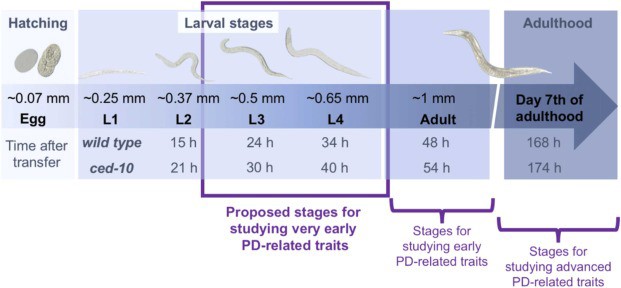New animal model created to study Parkinson's disease before neurodegeneration appears
A research team led by Dr Esther Dalfó has managed to generate and validate a new animal model. This model enables the examination of the initial phases of Parkinson's disease, occurring prior to the onset of motor symptoms, and the exploration of molecular processes preceding neuronal degeneration. The new model, based on the Caenorhabditis elegans worm, emerges as an essential tool in creating future therapies aimed at stopping the characteristic loss of neuronal structure and function seen in the disease.

The most obvious symptoms in Parkinson's disease, which are motor symptoms, appear when the disease has been developing for years and brain damage cannot be reversed. Therefore, understanding the progression during the initial phases can be of great help in making an early diagnosis and seeking treatments that can stop neurodegeneration in time.
The complexity and extended life cycles of existing animal models have hindered the study of Parkinson's disease during its preclinical stages. Now, a research team led by the Institut has presented a new model that allows investigating non-motor symptoms in the earliest stages of the disease. The animal model is the transgenic worm Caenorhabditis elegans RAC1/ced10, with which researchers were also able to detect the vital period in which the pathology begins and follow the process of protein accumulation causing it.
The study, published in the journal Progress in Neurobiology, was coordinated by Dr Esther Dalfó, researcher from the INc-UAB and the Institut de Recerca i Innovació en Ciències de la Vida i de la Salut a la Catalunya Central (IRIS-CC) and lecturer at the University of Vic-Central University of Catalonia (UVic-UCC).
People with Parkinson's disease initially present non-motor symptoms, followed by motor symptoms, regulated respectively by the neurotransmitters GABA and dopamine. Both symptomatologies are linked to the accumulation of alpha-synuclein proteins in the nervous system, which causes neuronal death, especially in neurons that secrete dopamine (dopaminergic). In addition to the abnormal accumulation of these and other proteins, patients also accumulate lipids in certain areas of the nervous system, although the exact role this may play in the progression of the disease is not yet known.
In this study, the research team showed that the novel animal model exhibits initial non-motor symptoms dependent on the GABA neurotransmitter. Furthermore, they confirmed the hypothesis regarding the crucial involvement of lipid metabolism in the disease's progression.
Dr Amanda Muñoz-Juan, first author of the article and researcher at the Institute of Materials Science of Barcelona (ICMAB-CSIC, points out that Caenorhabditis elegans RAC1/ced10 “will be useful in investigating changes in the proportion of lipids that can lead to an early detection of Parkinson’s disease, as well as the very first GABAergic symptoms. Both aspects are prior to the death of dopaminergic neurons and, therefore, this will allow investigating molecular mechanisms prior to neurodegeneration”.
An important worm for neuroscientific research
Caenorhabditis elegans is an important model organism for neuroscientific research. Many molecules involved in neuronal signalling and metabolism are conserved between this nematode and humans, and results obtained with these models have been predictive of outcomes for human diseases.
It is well-suited for neurodegeneration research due to its short lifespan, ranging from 15 to 20 days, facilitating comprehensive observation of the entire process. Additionally, its simple nervous system, comprising 302 neurons (merely 8 dopaminergic neurons and 26 GABAergic neurons), enables thorough monitoring of all occurring changes." “Dr Dalfó explains.
Dr Dalfó and her collaborators already demonstrated in a previous study that the RAC1 protein, known in C elegans as CED-10, protects dopaminergic neurons from the toxicity produced by alpha-synuclein, and that in Parkinson’s disease patients the activity of this protein is diminished. For this study, the team created the transgenic worm without the RAC1/ced10, in which alpha-synuclein accumulates and causes neuronal death.
Another advantage of C elegans is that their main lipid pathways are known and are the same as those in humans. In this study, the research team noted that, compared to the healthy worm, the new transgenic worm displayed alterations in the distribution of various types of lipids in its body from the earliest stages.
“The newly developed model provides an opportunity to investigate the initial phases of Parkinson's disease and other synucleinopathies prior to neuronal degeneration. This advancement offers the potential to identify medications capable of halting the progression of the disease before it becomes irreversible. “Dr Dalfó highlights.
Also participating in this study coordinated by the UAB’s Institut de Neurociències were researchers from the Institute of Materials Science of Barcelona (ICMAB-CSIC), the University of Alabama, USA, University of Vic - Central University of Catalonia and the Institut de Recerca i Innovació en Ciències de la Vida i de la Salut a la Catalunya Central (IRIS-CC).
Stages in the developmental cycle of C. elegans RAC1/ced-10 with the period proposed by the research team to study the initial phases of Parkinson’s disease, before the start of neuronal death. (Credit: Progress in Neurobiology).
Original article: Muñoz-Juan, A.; Benseny-Cases, N.; Guha, S.; Barba, I.; Caldwell, K. A.; Caldwell, G. A.; Agulló, L.; Yuste, V. J.; Laromaine, A., i Dalfó, E. «Caenorhabditis elegans RAC1/ced-10 mutants as a new animal model to study very early stages of Parkinson’s disease», Progress in Neurobiology, 234 (1 de marzo de 2024): 102572. https://doi.org/10.1016/j.pneurobio.2024.102572